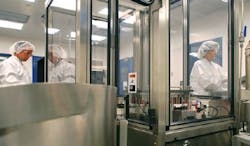FACED WITH HIGH COSTS, long development times, regulatory uncertainty and the need to differentiate products, pharmaceutical manufacturers are banking on drug delivery to deliver value. Drug delivery is “the great equalizer,” perhaps the only area of drug development where small players can trump mega-pharmas.
At its best, drug delivery achieves many of the goals of medicinal chemistry: solubilizing oily molecules, improving bioavailability and pharmacokinetics, allowing more favorable dosing over time, and targeting drugs to tissues – all while lowering doses and reducing side effects.
Fuji-Keizai USA estimates the 2002 global market for drug delivery systems at $47 billion, rising to $67 billion in 2006 based on estimated growth of about 8% per year. With blockbuster drugs losing $37 billion to generics between 2002 and 2006, the argument for innovative delivery of old treatments has never been better.
Enhancing already-approved drugs through drug delivery mitigates much of the risk associated with discovery, development, testing and approval, according to George Haley, Ph.D., at the University of New Haven’s Department of International Business. As such, drug delivery becomes both an offensive and defensive strategy. “R&D-based pharmaceutical firms depend on the flow of new drugs out of their pipelines – a difficult, risky enterprise made a lot less risky through new forms of products already known to be safe and effective,” Haley observes.
Perhaps the most prominent, technologically compelling example is PEGylation of proteins and peptides as practiced by Nektar Therapeutics (San Carlos, Calif.).
Through PEGylation, polyethylene glycol residues are chemically attached to peptides and proteins to improve pharmacokinetics and absorption. The company’s main approved PEGylation products include Neulasta (with Amgen) to boost white blood cell counts, PEGASYS PEGylated interferon (with Roche), and Macugen (with Pfizer), the first U.S.-approved PEGylated oligonucleotides, for treating macular degeneration.
Nektar has defined diabetes as a key therapeutic area. “Many peptides for treating the disease can be improved with less invasive or noninvasive delivery,” says Chris Searcy, Pharm.D., VP of corporate development.
Pharma Unit Operations Becoming Commoditized
“A fundamental goal of the pharmaceutical business is to manage product lifecycles,” says Jan Paul Zonnenberg, a director at consulting firm PRTM (Waltham, Mass.). That is becoming more difficult to do with conventional oral dosage forms and their associated unit operations, which Zonnenberg sees as becoming commoditized.
“Manufacturers no longer hold a competitive advantage by focusing on roller compaction, direct compression or fluid bed granulation,” he says. The key is to maintain competencies for developing new drugs and dosage forms, and to outsource the rest.
Advanced delivery systems, however, are still in their growth phase, so companies prefer to retain control over them, regardless of whether the technology is licensed or home-brewed. They might still outsource out of necessity. “Not because it’s cheaper or faster, but for capacity or capability reasons,” Zonnenberg adds. Such decisions are usually based on business tactics rather than long-term strategy.
Delivery enhancement adds steps to the manufacturing process, and if in-licensed, demands considerable technology transfer from the licensor to the innovator. This raises more delicate collaboration issues than, say, the outsourcing of a mature or generic active pharmaceutical ingredient.
Within the old specialty-delivery business paradigm, delivery companies are rewarded through royalties, a model that provides steady but unspectacular revenues. More recently, these firms – as well as manufacturers of generic drugs – have begun to tap into the vast pool of generic medications to manufacture (and in some cases market and sell) products developed in house.
For example, delivery specialty company Labopharm (Laval, Quebec) applied its Contramid controlled-release technology to tramadol, a non-opioid analgesic, while Biodelivery Sciences (BDSI; Morrisville, S.C.) has begun to offer fentanyl, an established treatment for breakthrough pain, via its BEMA oral adhesive-disk delivery platform.
According to BDSI CEO Mark A. Sirgo, Pharm. D., BEMA shines in rapid-onset applications, like analgesia for cancer or trauma patients, where intravenous delivery is impractical. BDSI’s oral fentanyl patch competes with Cephalon’s Actiq fentanyl lozenge, which enjoys sales of more than $400 million a year. Actiq is delivered to the oral mucosa through a lollipop-like device held in place by the patient.
A similar model is followed by Access Pharmaceuticals. Inc. (Dallas, Texas), which promotes in-licensed oncology compounds to late-stage clinical trials, then seeks a commercialization partner. The company’s water-soluble, polymer-based delivery platform allows high dosing directly to tumors. In the bloodstream, the polymer protects healthy cells from the drug. The lower pH inside cancer cells cleaves the polymer to release the active material. Access’ lead product, AP5346, a polymer-modified platinate oncology drug, is in Phase II testing. According to David Nowotnik, Ph.D., senior VP of R&D, this strategy allows 10-fold higher dosing compared with cisplatin, an old-line chemotherapy drug.
Depomed (Menlo Park, Calif.) has adopted a business strategy that John Shell, VP of operations, describes as “opportunistic”: creating new products from established drugs through value-added delivery technology.
The company claims it can create a new controlled-release, oral formulation for an existing drug in a few months and complete Phase I trials in about a year and a half, for approximately $1 million. Depomed says it can do all that while adding only about one cent (at the manufacturer level) to the cost of a dose. Approval takes two to four years, about average for new-delivery plays.
Depomed’s Gastric Retention (GR) technology produces “smart pills” that are retained in the anatomical region where the stomach meets the small intestine. From that point, GR delivers its drug payload through release kinetics based on one of four mechanisms (diffusion, erosion, bi-layer and combinations of these) while sparing the stomach and large intestine, where many side effects originate.
The company’s Proquin XR (ciprofloxacin) antibiotic is said to provide steadier pharmacokinetics and fewer gastrointestinal side effects than conventional oral Cipro. Depomed’s other products include Glumetza GR-metformin (for diabetes). GR versions of furosemide (for heart failure), and gabapentin (pain) are under development at Depomed, while Bristol-Myers Squibb has licensed GR for its own metformin product.
Ultrasound, Enzymes for Heavyweight Drugs
Active delivery could create opportunity for molecules of greater than 500 Dalton molecular weight. Georgia Institute of Technology (Atlanta) researchers have recently demonstrated a cell-gating effect using ultrasound. Prof. Mark Prausnitz, a biomolecular engineer, showed that ultrasound temporarily opens up pores in cells, making them penetrable by drugs as large as 50 nanometers across – bigger than most proteins. Investigators see this as a way to deliver proteins, genes, chemotherapy and other difficult-to-deliver drugs to otherwise refractory tissues.
Enzyme specialty firm Halozyme (San Diego, Calif.) exploits a similar strategy, but through enzymes. The company’s uman hyaluronidase enzyme, breaks down hyaluronic acid, a cement-like substance in the skin and other tissues. The hyaluronic acid replaces itself within 48 hours, but its temporary disintegration opens up 200-nanometer pores that permit passage of large biomolecules through the skin and into the bloodstream. Drugs normally delivered by infusion are thereby safely administered by bolus injection, freeing up clinic and hospital beds. Bovine hyaluronidase has been safely used in cataract surgery for at least 50 years; this material is animal component-free. Candidates for Enhanze delivery include monoclonal antibodies, cytokines and other proteins with fairly frequent dosing schedules.
A third approach, from Duke University, might be dubbed “if you can’t beat ’em, join ’em.” Ashutosh Chilkoti, Ph.D., causes cancer drugs to accumulate inside tumors by weighing the molecules down with added mass. Chilkoti noted that low molecular-weight compounds diffuse easily into and out of tumors due to leakiness in the tumor blood vessels. Larger molecules take longer to enter cancer cells, but remain inside much longer as well. So, exploiting tumor blood vessels’ high permeability, Chilkoti added dextran chains of 40,000 to 70,000 molecular weight to standard chemotherapy agents. The precise weight added to the chemo drugs varies for different drugs and tumors, but it is possible, using the molecular weight approach, to balance concentration within and without the tumor to optimize therapeutic benefit.
Patchwork
FDA approval of a scopolamine patch in 1979 for treating motion sickness set the wheels in motion for a host of transdermal delivery products. A study by Jain PharmaBiotech pegged drugs delivered transdermally at $13 billion in 2004, with projected sales of $22 billion in 2010 and $32 billion in 2015.
Getting drugs through skin takes a fair amount of engineering, since the active ingredient should have a molecular weight below about 500, be lipophilic in character, and have an effective dose in the low milligram range. Thus, transdermal delivery tends to be formulation- and manufacturing-intensive.
The rewards can be substantial, however. The Ortho-Evra contraceptive patch, approved in the U.S. in 2002, precipitated an immediate jump in sales, to nearly $400 million per year. Another transdermal product, the fentanyl patch, enjoys blockbuster-like sales of about $1 billion per year.
Transdermal patches and their close cousins, implantable delivery systems, illustrate how much drug delivery has come to depend on materials science. NuSil Technology (Carpinteria, Calif.) produces one material: silicones. After its spinoff from Dow in 1992, the company focused for a while on medical devices, but about 10 years ago it began investigating silicone’s potential as a vehicle for implantable drug delivery. Silicone is quite amazing in its “tunability” as a drug reservoir. “It’s possible to control drug elution simply by modifying the composition of the material,” explains Stephen Bruner, director of marketing.
Hormone replacement is probably the most recognizable implantable drug delivery application for silicones, but the material can do much more. Some pharmaceuticals may be cured within the silicone elastomer and applied transdermally, transmucosally, or by implant (e.g. drug-eluting stents). Or the material can serve as a reservoir for larger quantities of drugs, with semi-permeable patient-contact surfaces for releasing drugs in a controlled manner. Candidate drugs include analgesics, steroids, hormones, biologics, vitamins and cosmeceuticals. Typically, the drugs must be potent, hydrophobic, relatively soluble in silicone monomer and require chronic administration.
Through the Nose
Intranasal drug delivery is also coming of age. As of this writing, close to 20 Investigational New Drug (IND) applications were in the works for nasal analgesics, mostly established medications, according to BioPharm Insight. Nasal delivery offers safety, ease of administration, rapid absorption and onset of action, and, with the right compound, relatively low dose requirements.
The intranasal delivery route has a lot going for it, but devices for delivering drugs into the nose are notoriously inaccurate. As recently as 1998, the most accurate device for nasal sprays suffered from dose variability of 30%, about the same as squeeze bottles for over-the-counter cold remedies.
The accuracy problem appears to have been solved, with the introduction of a super-accurate, single-dose nasal delivery system developed by Pfeiffer (Radolfzell, Germany) and adopted by GlaxoSmithKline for its Imitrex migraine drug. This particular formulation was not a winner for GSK, as patients preferred the oral vehicle.
But the delivery technology piqued the interest of Intranasal Therapeutics (ITI; Montvale, N.J.) CEO Edwin Cohen. With help from the University of Kentucky School of Engineering, Cohen produced a multi-dose nasal delivery system which is as accurate as the Pfeiffer device, but provides up to 12 doses.
ITI has applied this technology to four drugs: the anti-anxiety agents lorazepam and midazolam (both in Phase I testing), hydromorphone for moderate-severe pain (Phase II), and butorphanol for migraine (Phase III). Because these drugs and the device were already FDA-approved, ITI is pursuing the 505(b)(2) approval path (reserved for delivery system modifications).
ITI’s platform works for potent drugs with low to moderate molecular weights (under about 1000). Cohen believes that it will work with proteins and peptides, as well with an appropriate enhancer (such as an nonionic surfactant) that can coax the drug across the nasal mucosa.
Proteins and Nanotech -- Combining “Killer Apps”At the Center for Pharmaceutical Science and Technology at the University of Kentucky (Lexington), a contract formulation facility, about half the incoming projects involve biologics, and 80% employ some type of nanotechnology, for example liposomes, plasmid-polymer precipitate complexes (for gene therapy), and photoreactive polymer-based microparticles. Most of the Center’s customers are small, semi-virtual pharmaceutical and biotech companies that “outsource everything,” says Joseph Wyse, Ph.D., general manager, to support process development for preclinical testing and early-stage human studies. Like most pure-play delivery/formulation providers, the Center does not manufacture APIs, and its services are non-GMP. “The products we make are not commercial, but the process is commercializable.” Aphios (Woburn, Mass.) CEO Trevor Castor, Ph.D., says that proteins will be the “killer app” of drug delivery, and that nanotech “could change the landscape of biotech.” By solubilizing macromolecules through its SuperFluids™ nanotech platform, the company creates protein nanoparticles for pulmonary delivery, nanospheres for oral or depot administration, and phospholipid nanosomes for intravenous or topical delivery. Nanoparticles have the potential for lower toxicity compared with standard formulations by imparting higher bioavailability (and hence lower dosing). This holds for potent cancer drugs as well as vaccine antigens. Aphios is therefore working on polymer nanosphere versions of cancer drugs taxol, camphothecin, and bryostatin. Flamel’s (Venissieux, France) nanoparticle platform, Medusa, is based on self-assembled poly-amino acid nanoparticle formulations of therapeutic proteins. Medusa encapsulates drug and releases it after in target tissues, then breaks down into safe amino acids. Flamel’s lead products are Basulin long-acting insulin (late Phase II), which is licensed to Bristol-Myers Squibb, and IFNalpha-2b XL, a long-acting interferon (Phase I), and interleukin-2 (Phase I). Calcium phosphate nanoparticles from BioSante’s (Lincolnshire, Ill.) serves as an all-purpose delivery platform, BioVant, for vaccines. Calcium phosphate serves both as delivery agent and adjuvant, which reduces manufacturing complexity and regulatory uncertainty. To protect oral peptide and protein antigens, the nanoparticles are “shrink wrapped” with casein, keeps acid and degrading enzymes away from the drug. Drug-carrying, porous nanospheres based on lactide-galactide copolymer (used in biodegradable sutures) are the specialty of Acusphere (Watertown, Mass.). Depending on their size and surface, the particles can hold, deliver, and release solids or gases for as long or short a time as desired. Applications include delivering small molecules, peptides/proteins, or gases as ultrasound contrast agents. |




